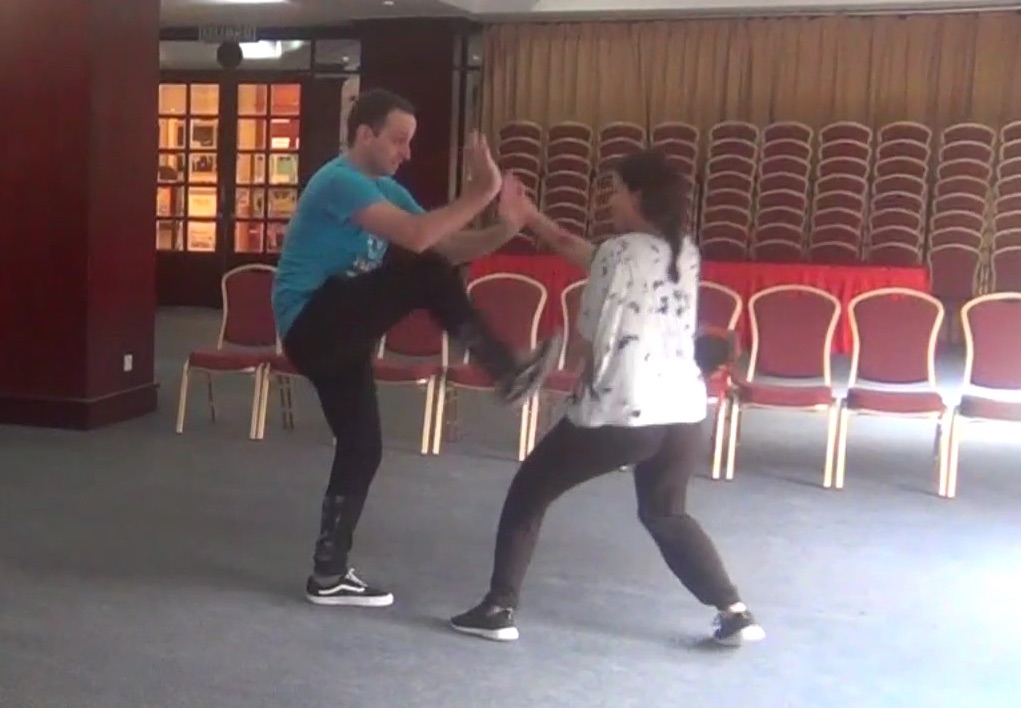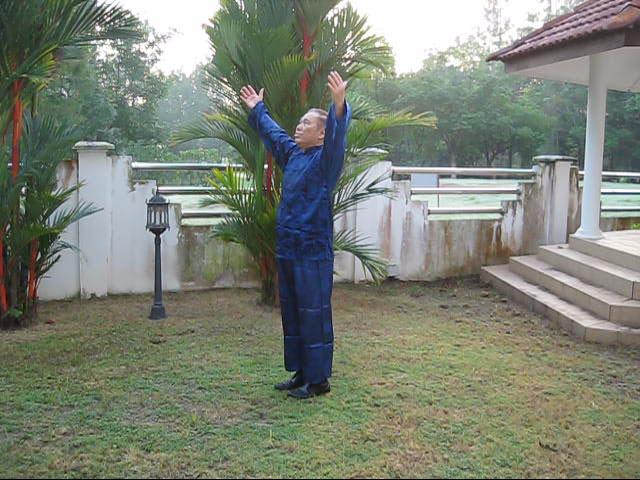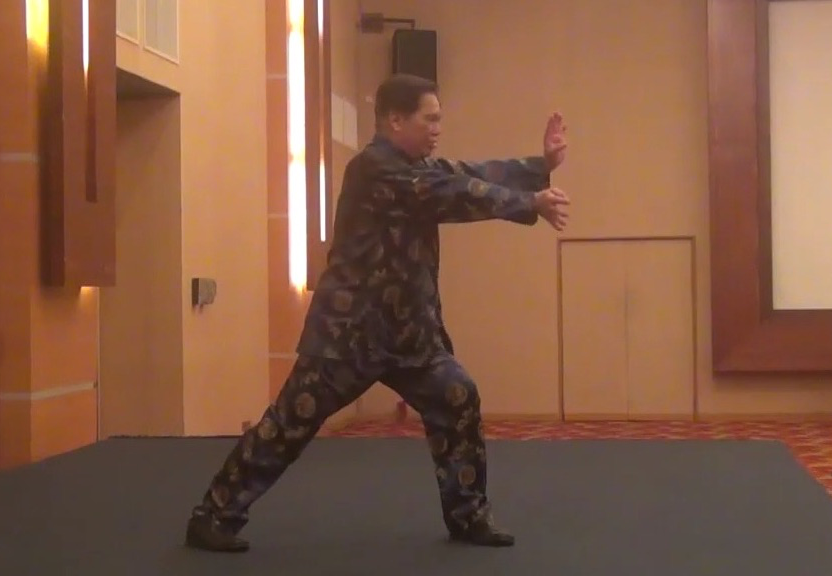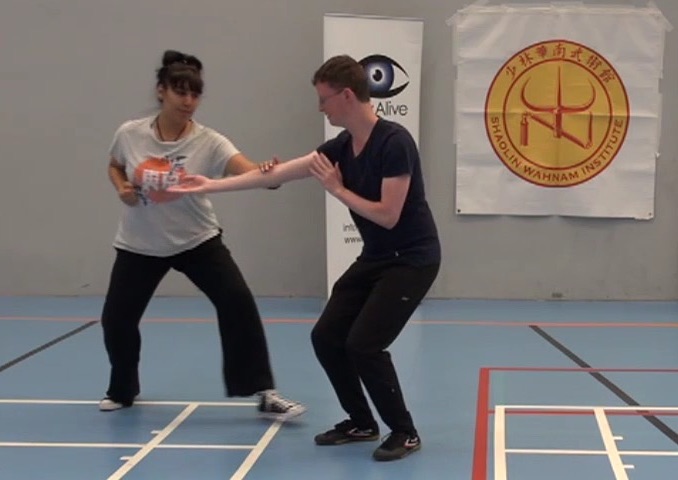SELECTION OF QUESTIONS AND ANSWERS
SEPTEMBER 2019 PART 2

Just have a thought that an opponent is kicking you, and then respond accordingly
Question 1
What is the difference between visualization and a gentle thought?
— Sifu Michael Simon, Shaolin Wahnam USA
Answer
By visualization I mean having an image in the mind. By a gentle thought I mean gently and intuitively thinking of the relevant action. For example, in kungfu training, visualizing an opponent kicking you is to have an image of an opponent kicking you. To have a gentle thought means gently and intuitively thinking of an opponent kicking you.
This difference between visualization and a gentle thought became problematic when Douglas, my most senior disciple in the West since my world travels, told me that he had problems visualizing an opponent kicking him. He explained that he would visualize how an opponent kicked him, including the dress as well as the shoes of his opponent. I explained that he needed not go into details, but just gently thought of an opponent kicking him, not caring how he kicked or what dress or shoes he wore.
In Chinese, it is “ka seong” in Cantonese or “jia xiang” in Mandrin, which literally means “false imagination” or figuratively “having a thought”. It must be done gently and intuitively, not intellectualizing.
Question 2
Some students use “Lifting Sun and Moon” and some use “Gathering Chi to Dan Tian” when starting their sets. Is there a difference between these two exercises?
— Pax, Spain
Answer
Relatively, “Lifting Sun and Moon” focuses on consolidated force, and “Gathering Chi to Dan Dian” focuses on flowing force. That does not mean that the force in “Lifting Sun and Moon” is not flowing, or the force in “Gathering Chi to Dan Tian” is not consolidated. It is just relative.
Again relatively, consolidated force is more for work, and flowing force is more for health. If a practitioner wants to focus on work, like engaging in combat or performing daily tasks, he uses consolidated force. If he wants to focus on health, like overcoming illness or living a long life, he uses flowing force.

Gathering Chi to Dan Tian
Question 3
Why is it that when the movements are big and slow, we can generate more internal force? When did you first discover this?
— Sifu Barry Smale, Shaolin Wahnam UK
Answer
It is not always so. When one uses muscular strength, which depends on mass and speed, the faster his strikes are, the more powerful they become. When one uses internal force, which depends on the volume and speed of energy flow, when one is fast his strikes become more forceful.
Nevertheless, having big and slow movements is an important way to generate more internal force, and is used in Taijiquan and the “xuan wu” or the tortoise method. Big and slow movements generate more energy, hence they increase internal force.
I cannot remember when I first discovered this. It must be during my Taijiquan practice. When I perform the movements exceedingly slowly using the tortoise method, it produces tremendous internal force.
Question 4
Can you please tell us more about the principles of gradual progress and of persistent training?
— Westlee, England
Answer
These two principles are particularly important in force training. Suppose a practitioner wants to develop internal force to break a brick.
He graduates his force development from 1 to 100, 1 being with very little force, and 100 being with much force, with which he could break a brick. Let us say he has 100 planks with different thickness, and he lines them up from 1 to 100. The 1st is a very thin plank which he can break easily, but the 100th plank is thick which he cannot break now. When he can break the 100th plank, he can break the brick.
The 1st day he breaks the 1st plank. The 2nd day he can easily break the 2nd plank. Not only the thickness between the 1st plank and the 2nd plank is not much, he also has some training breaking the 1st plank. If he progresses gradually and trains persistently, he will be able to break the 100th plank in 100 days, and therefor has the force to break a break.
After 25 days, he can break the 25th plank. But the next day instead of breaking the 26th plank, he attempts breaking the 36th plank. He may not be able to break it because his progress is not gradual. He jumps from the 26th plank to the 36th plank.
Instead of breaking the next plank, he stops breaking planks for a month. After the month, he attempts the 26th plank. He may not be able to break it because his training is not persistent.
In kungfu terminology in Cantonese Chinese it is called “chien kung chun fai”, which means “the force he has developed earlier is now lost”. He would have to start afresh at the 1st plank.
If a student is ready to follow these two principles of gradual progress and of persistent training, and if he has a teacher willing to teach him and there is available a method, he can attain any force. These two principles are often the main reasons why students fail.

The Butterfly Palm can be appled in a miraculous way
Question 5
Is force the deciding factor in combat?
Answer
The answer is “yes” and “no” depending on the attainment of the combatants.
There is a kungfu saying as follows: “lek pat ta kuen, kuen pat ta kung, kung pat ta fei, fei pat ta miu”, which means
- strength is no match for technique
- technique is no match for force
- force is no match for speed
- speed is no match for the marvelous
Someone with muscular strength is no match against another who has techniques. You can use techniques to defeat a strong person. For example, when a strong person with muscular strength tries to grasp you, if you have appropriate techniques you can fell him using his strength.
If an opponent has good techniques but he lacks force, you can defeat him with just one punch. He may hit you using techniques which do not harm you, but a powerful punch can end the combat. A good example is a juvenile Karate black-belt fighting with an able-bodied adult who does not know any fighting art.
An opponent may be very powerful, but if you are fast, he cannot hit you. In kungfu we use this strategy of “leading an opponent to futility”, and defeating him with a decisive strike.
The highest level is the marvelous. It can mean “just nice”. You cannot hit a person who is marvelous no matter how sophisticated your techniques are, how powerfully you can hit, or how fast you can be. He is just marvelous, defending or avoiding your attacks, and defeating you in ways you may not even understand.
The Essence of Shaolin Course trained the marvelous. Those who missed it, just missed it.
Question 6
During the course, you had us create our own combat sequences, and I think this was a brilliant method for training us to link together patterns in a meaningful way.
— Sifu Michael Simon, Shaolin Wahnam USA
Answer
Two of the best methods we use in our teaching are to ask students to demonstrate the combat applications of the patterns in the set they practice, and then to link the patterns into combat sequences.
The first method enables students to know the combat application of every pattern in their set. This is a remarkable achievement. Most people do not know the combat applications of the set they practice though they may have practice the set for many years.
The second method enables students to appreciate the composition of their set. Not only many practitioners do not know the combat applications of the patterns in their set, they also do not know why the set was composed the way it was. They only practice the set the way it was taught to them by their teachers.
For our convenience we can classify sets into four types according to their composition, namely
- Pattern-sets
- Sequence-sets
- Force-training-sets
- Mixed-sets
Force-training sets are those for force training. An excellent example is Iron Wire Set. Initially I thought that San Zhan was mainly for training internal force in Wuzuquan, but later I found out that the patterns can be used against any attack!
Most kungfu sets are mixed-sets, which means that they include various functions in their composition. Typical mixed-sets are those in Southern Shaolin like Flower Set and Triple Stretch where the first part is used for force-training called “ta chong” (or force training in stances), and the later part for combat called “ta sai moon” (or striking four directions).
Taijiquan sets are mixed-sets though they do not have “ta chong”. The whole set is used for training internal force, and the whole set can be used for combat though the patterns are sometimes not arranged in combat sequences.

Parveen and Sifu Simon in a combat sequence during the UK Summer Camp 2018
Question 7
I’m curious how we can best incorporate this skill into our own practice?
Answer
We may not incorporate this skill in all sets because this skill is already found in most sets, though most practitioners are unaware of the fact. In other words, for most sets we just practice the sets in a meaningful way, bearing in mind force-training and combat application, which are the two pillars of any kungfu training. Most practitioners are unaware of force-training and combat application in their sets.
However, for some sets the techniques of which you may want to use in your free sparring, you may compose short combat sequences for your purpose. Practice the short combat sequences well, and apply them in your free sparring taking extra care to cover your opponent adequately. You may need to check what type of techniques your opponent uses, and plan your short combat sequences accordingly. Nevertheless, if you have a few short combat sequences against Boxers and Kick-boxers, you will be able to deal with most opponents.
The skill you used in composing combat sequences of the Abridged San Feng Set is very useful. As skills are general, you will be able to use this skill in all techniques.
Question 8
Can we continue to make new sequences, in addition to practicing our existing ones? What goals or aims might best be achieved by our making new sequences?
Answer
As you already have the skill, you can make new combat sequences when the need arises. Generally you need not do so with the sets you are practicing as they are already composed in certain ways for your benefit.
The goals or aims are to understand why sets are composed in the ways they are. A very important goal is to apply your combat sequences spontaneously on your opponents in the way they normally fight. This, indeed, is how masters are made.
If you have any questions, please e-mail them to Grandmaster Wong via his Secretary at stating your name, country and e-mail address.
LINKS
Selected Reading
- Yin-Yang Harmony and Jing, Qi, Shen
- Cabo da Roca, the Westernmost Point in Europe
- Lifting the Sky, Lifting Sun and Moon, and Thirty Punches
- Focusing Chi at Dan Tian
- A Happy Ending
